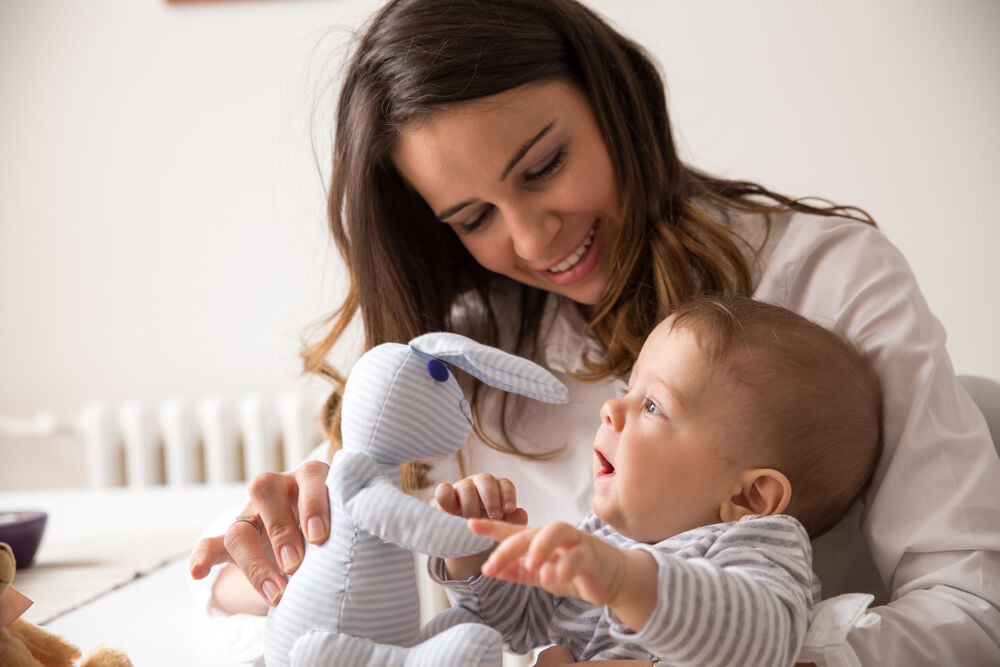Your baby is halfway through their first year of life, growing and changing right before your eyes. As they’ve progressed over the last several months, you may have noticed a few things along the way.
-
Tracking cycle
-
Getting pregnant
-
Pregnancy
-
Help Center
-
Flo for Partners
-
Anonymous Mode
-
Flo app reviews
-
Flo Premium New
-
Secret Chats New
-
Symptom Checker New
-
Your cycle
-
Health 360°
-
Getting pregnant
-
Pregnancy
-
Being a mom
-
LGBTQ+
-
Quizzes
-
Ovulation calculator
-
hCG calculator
-
Pregnancy test calculator
-
Menstrual cycle calculator
-
Period calculator
-
Implantation calculator
-
Pregnancy weeks to months calculator
-
Pregnancy due date calculator
-
IVF and FET due date calculator
-
Due date calculator by ultrasound
-
Medical Affairs
-
Science & Research
-
Pass It On Project New
-
Privacy Portal
-
Press Center
-
Flo Accuracy
-
Careers
-
Contact Us
Key Milestones for Your 6-Month-Old Baby


Every piece of content at Flo Health adheres to the highest editorial standards for language, style, and medical accuracy. To learn what we do to deliver the best health and lifestyle insights to you, check out our content review principles.
6-months developmental milestones
There are certain indicators to look out for when you’re trying to determine if your child is exactly where they should be at their age. Below are some of the most critical 6-month-old baby milestones.
Height and weight
Early on, infants gain weight at a very rapid rate, packing on at least a pound and a half, or even two, per month.
At around the six-month mark, just as you’re losing your pregnancy weight, your little one’s weight should be leveling off a bit. They’ll only put on about a pound per month, with their total body weight being roughly twice as much as it was at birth.
Even their height progression slows down to approximately an inch per month at this stage. As a result, your 6-month-old will weigh somewhere between 12 and 22 (5.5-10 kg) pounds, and measure between 23 and 28 (59-72 cm) inches tall.
Physical activity
Being able to sit up well, without support, is an essential step for your child. From a sitting position, your 6-month-old can maneuver themselves onto the floor and move around, whether it’s by rolling, crawling, or shuffling on their bottom.
They should now also be able to roll from face down to face up, or vice versa, and transfer objects from one hand to another. Lastly, you may notice your baby bringing toys up to their mouth or banging them repeatedly on the floor.
Most importantly, as your little one is becoming increasingly mobile, take special care to keep any small objects or medications out of their reach.
Sleep patterns
Another significant milestone is when your child begins sleeping through the night (in other words, six to eight hours). Additionally, they might be taking three or four naps during the day, totaling two to three hours.
In this phase, it’s not unusual to find your baby lying on their stomach even after you’ve placed them into the crib on their back.
Whenever they’re having trouble falling asleep, consider utilizing the Ferber method. This strategy involves waiting for progressively longer periods of time before going in to comfort and lull them to sleep to help foster independence. Soon, your baby will be able to self-soothe, giving you ample time to sleep as well.
Senses

At this particular stage of development, your child’s beginning to see the finer details of the objects around them. Whereas before, they were interested in larger shapes and brighter colors, they’re now fascinated by unique patterns, textures, and shapes. They’re also more likely to reach out for things in order to experience what it feels like to hold them in their tiny hands.
Eating habits
Although you’re still breastfeeding five to six times a day now, it’s a good idea to slowly introduce mashed-up, solid foods into your baby’s diet. Watch out for certain signs that they’re ready to make the transition. These include better hand-to-mouth coordination, decreased tongue protrusion reflex, being able to sit up well, and opening their mouth for the spoon.
Remember to avoid foods that are choking hazards, including small fruits, raw vegetables, nuts, candy, gum, and whole grapes. Incorporate solid foods gradually so you can gauge their reaction. Taste-wise, it’s best to work your way from bland to sweeter or saltier. Whenever your little one dislikes something, take it off the menu and try reintroducing it later.
Always remain wary, however, of possible allergies. New foods should be added individually, and at least a week apart, so you can clearly identify what they can or can’t handle. Steer clear of honey and cow’s milk until they’re at least a year old as they both carry potentially harmful bacteria.
Finally, it’s important to note that the daily caloric requirement for 4 to 6-month-olds is roughly 690 kilocalories per day for boys and 645 kcal per day for girls. Between 7 and 9 months, it increases to 825 kcal for boys and 765 kcal for girls.
Communication skills
Right now, your 6-month-old is probably smiling at recognizable faces or funny sounds and expressions made by you. They’re also making plenty of babbling noises of their own, especially while playing with their toys. These are all signs that point to a happy, healthy, growing baby.
Nurturing your 6-month-old baby’s development
Take a quiz
Find out what you can do with our Health Assistant

Your little one needs all the love, encouragement, and support they can get, and there are countless ways for you to help, such as:
- Getting routine vaccinations to ensure proper growth and development.
- Easing the transition to solid foods by adding breast milk to their cereal to create a familiar consistency.
- Reading stories to them to improve their language and communication skills down the road.
- Introducing different toys at playtime, including soft toys, hard toys, and objects that are colorful or play music. Also, consider placing items just out of your baby’s reach to enhance mobility.
How to help your 6-month-old baby develop
Although each child progresses at their own unique pace, there are specific 6-month milestones that every parent should look out for.
By this age, most babies are able to sit up unassisted. Even if it’s not in a perfectly straight-backed posture, they usually assume a tripod position – planting their hands in front for stability.
Another possible cause for concern is when your baby isn’t making eye contact with you or anyone else, which is sometimes an early sign of autism.
As for auditory development, your 6-month-old should be reacting to any sounds they hear by looking for its source or smiling and babbling in response.
If you’ve noticed any of the above issues, please be sure to consult your pediatrician for further examination.


Hey, I'm Anique
I started using Flo app to track my period and ovulation because we wanted to have a baby.


The Flo app helped me learn about my body and spot ovulation signs during our conception journey.


I vividly
remember the day
that we switched
Flo into
Pregnancy Mode — it was
such a special
moment.
Real stories, real results
Learn how the Flo app became an amazing cheerleader for us on our conception journey.




